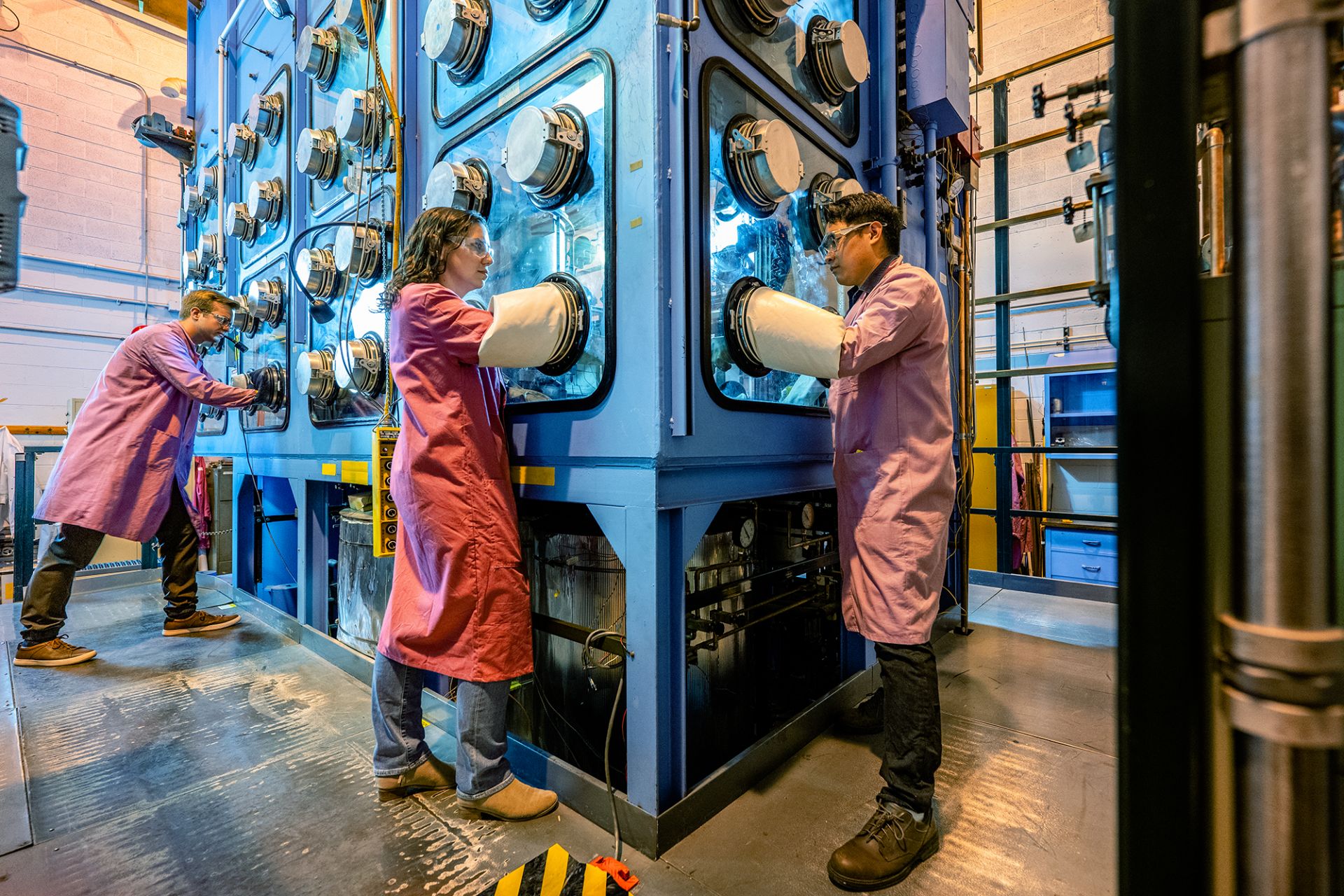ICP crews inspect transuranic waste drums to ensure they comply with shipping requirements. (Photo: DOE)
The Department of Energy’s Idaho Cleanup Project (ICP) has improved transuranic waste operations to address aging waste containers being stored at the Advanced Mixed Waste Treatment Project (AMWTP) at the Idaho National Laboratory Site, the DOE’s Office of Environmental Management announced on December 10.
IWTU operators monitor radiological operations during the current waste treatment campaign at the Idaho National Laboratory Site facility. (Photo: DOE)
As of last week, crews with Department of Energy cleanup contractor Idaho Environmental Coalition (IEC) processed more than 142,000 gallons of radioactive sodium-bearing tank waste at Idaho’s Integrated Waste Treatment Unit (IWTU) this year.
A rendering of a data center powered by Radiant's Kaleidos microreactors (shown in the foreground). (Image: Ryan Seper)
Radiant Industries has announced a $100 million Series C funding round to be used primarily to complete its Kaleidos Development Unit (KDU) microreactor for testing in Idaho National Laboratory's Demonstration of Microreactor Experiments (DOME) facility within two years.
INL team removing and staging irradiated ANEEL fuel rodlets in the ATR canal. (Photo: Clean Core)
A view of Oklo’s preferred site at INL. (Photo: Oklo)
Oklo Inc. announced yesterday that it has partnered with “two major data center providers” under letters of intent (LOIs) to deliver up to 750 MW of power from multiple 15 MW or 50 MW Oklo microreactors at data centers in “select” undisclosed U.S. markets.
The S5G prototype, which was constructed to simulate submarine operations and could mimic ocean-like conditions, is positioned inside a subgrade basin. (Photo: IEC)
The Department of Energy is proposing to fully decommission the Submarine 5th Generation General Electric (S5G) prototype at the Naval Reactors Facility on the Idaho National Laboratory site. Along with the Environmental Protection Agency and the state of Idaho, the DOE has initiated a 30-day public comment period (ending November 14) on the planned end state for the facility and its defueled reactor vessel.
At INL's Fuel Conditioning Facility, spent nuclear fuel material is being recycled into fuel for Oklo's commercial Aurora Powerhouse deployment at INL. (Photo: INL)
Oklo Inc. announced yesterday that a safety design report for the Aurora fuel fabrication facility the company plans to build at Idaho National Laboratory has the approval of the Department of Energy. At the facility, Oklo plans to use high-assay low-enriched uranium (HALEU) that has been recovered from used Experimental Breeder Reactor-II fuel to produce fuel for its first planned microreactor—dubbed Aurora—which is also set for deployment at INL.
The EBR-II dome, site of the DOME advanced reactor test bed. (Photo: INL)
Jeff Waksman (left), Project Pele program manager for DOD-SCO, and John Wagner, INL director, at the planned testing site. (Photo: DOD)
The Department of Defense announced September 24 that it has broken ground on the site at Idaho National Laboratory’s Critical Infrastructure Test Range Complex (CITRC) where Project Pele, a transportable 1–5 MWe microreactor, will be tested. The DOD’s Strategic Capabilities Office (SCO) is in charge, on a mission to prove that a mobile microreactor can help meet the DOD’s increasing demand for resilient carbon-free energy for mission-critical operations in remote and austere environments.
Heat pipes transfer heat out of the eVinci microreactor’s core and allow for air cooling without using water or pressurized gas. (Photo: DOE)
Westinghouse Electric Company has completed the front-end engineering and experiment design (FEEED) for a prototype microreactor at Idaho National Laboratory, the Department of Energy recently announced. The one-fifth scale version of eVinci, Westinghouse’s 5-MWe sodium-cooled heat pipe design, is one of three reactors that could be tested at the National Reactor Innovation Center’s (NRIC) DOME test bed “as early as 2026,” the DOE said.
Idaho National Laboratory employees consult on a microgrid at Utah’s Dugway Proving Ground. Two solar projects were selected for development on INL land. (Photo: INL)
On July 28, 2023, the Department of Energy launched its Cleanup to Clean Energy initiative, an effort to repurpose underutilized DOE-owned property—portions of which were previously used in the nation’s nuclear weapons program—into the sites of clean-energy generation.
Crews with the Idaho National Laboratory Site’s IWTU replace filter bundles inside the unit’s process gas filter. (Photo: DOE)
The Department of Energy’s Office of Environmental Management announced yesterday that waste processing operations have resumed at the Integrated Waste Treatment Unit (IWTU) at the Idaho National Laboratory Site. The resumption of operations follows the completion of two maintenance campaigns at the radioactive liquid waste treatment facility.
Work crews at the INL Site prepare to move Peach Bottom fuel from a transfer cask to a storage vault. (Photo: DOE)
Crews at the Department of Energy’s Idaho National Laboratory Site recently completed work to transfer baskets of spent nuclear fuel ahead of a September 30 deadline.
The MASS-DEF framework with prevention actions and timelines modeled in EMRALD software interacting with force-on-force (FoF) simulation and thermal hydraulics models. The risk-informed modeling in the MASS-DEF framework integrates physical security effectiveness analysis with safety measures, such as time to core damage. (Graphic: INL)
Today’s nuclear power plants are the nation’s largest source of carbon-free energy, but they come with high operating and maintenance costs.
Competition from other sources, especially natural gas, coupled with low electricity prices, has resulted in the closure of some plants in the last decade due to economic reasons.
One way to alleviate these economic pressures is to reduce the cost of operating nuclear power plants, including the costs associated with physical security.
Engineers in Argonne’s Chemical and Fuel Cycle Technologies Division. (Photo: Argonne National Laboratory)
Oklo Inc. announced that it has completed the first end-to-end demonstration of its advanced fuel recycling process as part of an ongoing $5 million project in collaboration with Argonne and Idaho National Laboratories. Oklo’s goal: scaling up its fuel recycling capabilities to deploy a commercial-scale recycling facility that would increase advanced reactor fuel supplies and enhance fuel cost effectiveness for its planned sodium fast reactors.
INL’s new Bitterroot supercomputer installed in the Collaborative Computing Center. (Photo: INL)
A new supercomputer named Bitterroot started operating in June at Idaho National Laboratory’s Collaborative Computing Center (C3) and is speeding up nuclear energy research by improving access to modeling and simulation tools. Bitterroot arrived at INL in March, and the announced July 15 that the supercomputer was open to users on June 18 after installation and an extensive program of testing.
















